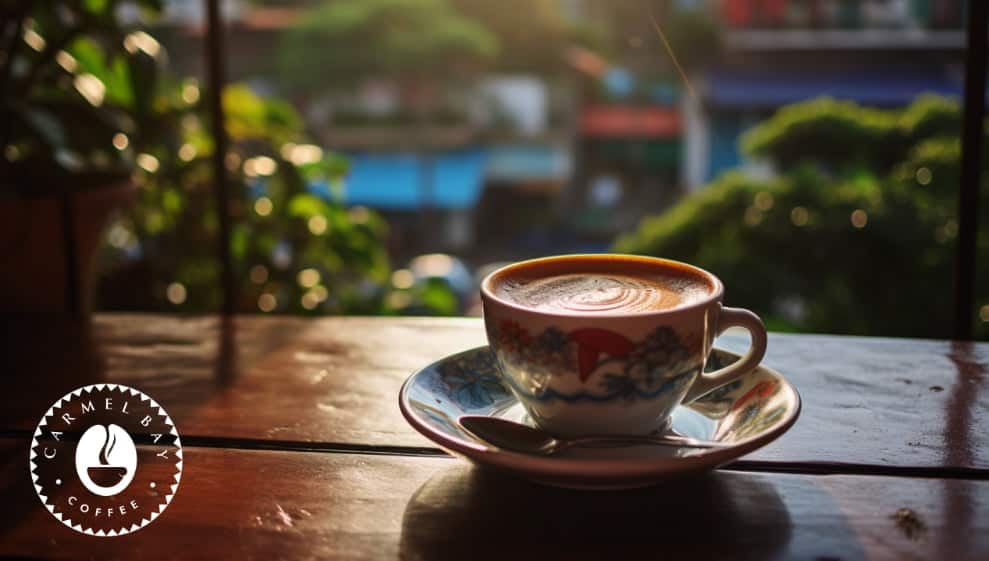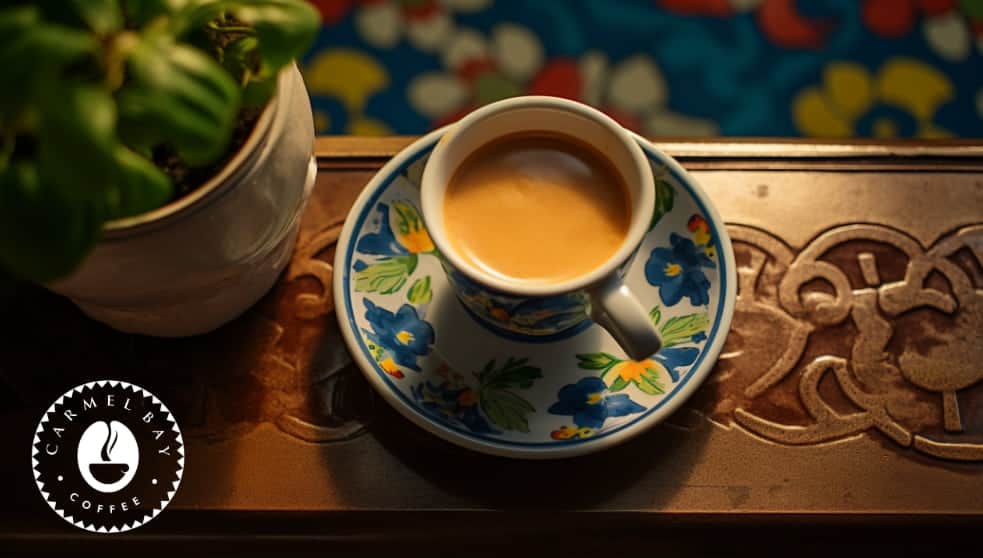From the bustling streets of Rio de Janeiro to the quaint corners of Salvador, there’s a unanimous language understood by all: the Cafezinho. This petite coffee, whose name translates to “little coffee”, is more than a drink; it’s a gesture of warmth, an invitation to converse, and the very essence of Brazilian hospitality.
What is a Brazilian Cafezinho Coffee

The Brazilian Cafezinho, simply known as ‘Cafezinho’, originates from the vast coffee fields of Brazil. Its name translates to “little coffee,” but don’t let the diminutive term fool you; it’s packed with flavor and culture. It’s made by boiling finely ground, dark-roast coffee with sugar and water.
Taste Profile
Cafezinho carries a bold yet slightly sweet flavor, often complemented by sugar that’s brewed directly with the coffee, resulting in a drink that’s as sweet as it is strong.
What Makes It Special?
Beyond its taste, the Cafezinho’s charm lies in its method of preparation and its role as a Brazilian gesture of hospitality. Serving a Cafezinho is akin to extending a warm, aromatic embrace to its recipient.
Coffee Grind Size For Brazilian Cafezinho
For the Cafezinho, a medium to fine grind is ideal. This grind size ensures maximum extraction of flavors without over-extracting, which can lead to bitterness. Achieving this right grind size is paramount in crafting the perfect Cafezinho.
Coffee Roast Recommendation For Brazilian Cafezinho
Opt for a medium to dark roast. These roasts highlight the coffee’s natural sugars and complement the sweetness of the Cafezinho.
Brewing the Perfect Brazilian Cafezinho
Ingredients
- Freshly ground coffee (medium to fine)
- Cold water
- Sugar (to taste)
How to Make a Brazilian Cafezinho
- Start by measuring out your coffee. For a traditional Cafezinho, use roughly one tablespoon of coffee for each demitasse cup of water.
- Add your desired amount of sugar directly to the coffee grounds.
- Heat the water until it’s just about to boil and add it to the coffee and sugar mixture.
- Stir to ensure even brewing, allowing it to steep for a few minutes.
- Pour the brew through a fine strainer into a cup, ensuring no grounds make their way into your drink.

Aroma
Inhaling the aroma of a freshly prepared Cafezinho is like a gentle stroll through Brazilian coffee fields. There’s an enticingly bold coffee aroma, underscored by a caramel-like sweetness.
Taste
Balanced yet bold, the Cafezinho is both sweet and robust. Its taste profile stands out, with the direct addition of sugar during brewing amplifying the coffee’s natural flavors.
Sensation
Sipping a Cafezinho is not just about the taste; it’s a complete sensory experience. The warmth of the drink combined with its rich flavor profile creates a sensation of comfort and pleasure.
As we’ve journeyed through the cultural significance of the ‘Cafezinho’ in Brazil, it’s fascinating to see how coffee is celebrated and enjoyed in different ways globally. For those curious to explore diverse brews and concoctions, hop aboard our global coffee tour with ‘Top 10 Coffee Recipes from Around the World’. Expand your palate and experience how the world wakes up, one cup at a time.
Tips and Variations: Brazilian Cafezinho
Go Traditional: Serving Methodology: The beauty of Cafezinho lies in its simplicity and intensity. Traditionally, it’s poured into small, demitasse cups, much like espresso. This not only enhances its rich aroma but ensures the coffee remains hot, given its small volume.
Experience: Enjoying Cafezinho in a small cup accentuates its boldness, ensuring each sip is an explosion of flavors. It’s a cultural nod to the Brazilian way of savoring moments – short, intense, and memorable.
Milk Mix: Regional Preferences: While Cafezinho is predominantly a black coffee, certain parts of Brazil, especially the southern regions, sometimes add a splash of milk or cream. This variant is often referred to as “pingado” when ordered at local bakeries or cafes.
Texture and Flavor: The addition of milk or cream mellows down the strong coffee, lending it a creamy consistency and a slightly subdued taste profile. This variation is perfect for those who prefer their coffee a tad less potent but still desire the authentic Brazilian experience.
Herbal Touch: Flavor Enhancers: Brazil, with its vast biodiversity, has a plethora of aromatic herbs and spices. Incorporating elements like cinnamon or cloves isn’t just an experimentation but a fusion of the country’s rich flora with its coffee culture.
Method: When you’re boiling the water and sugar for the Cafezinho, toss in a cinnamon stick or a couple of cloves. These spices release their essential oils during the boiling process, subtly infusing the coffee with their distinctive flavors.
Experience: This aromatic infusion takes the traditional Cafezinho to another level. The warmth of cinnamon or the slight pungency of cloves adds depth, creating a multi-layered sensory experience. It’s a harmonious blend of Brazil’s lush environment and its treasured coffee.
Nutritional Information
- Calories: 2 (without sugar or additives)
- Fat: 0g
- Carbohydrates: 0g (excluding sugar)
- Protein: 0g
The Art of Brewing the Brazilian Cafezinho
Equipment
- 1 Espresso Machine or Moka pot
Ingredients
- Freshly ground coffee medium to fine
- Cold water
- Sugar to taste
Instructions
- Start by measuring out your coffee. For a traditional Cafezinho, use roughly one tablespoon of coffee for each demitasse cup of water.
- Add your desired amount of sugar directly to the coffee grounds.
- Heat the water until it’s just about to boil and add it to the coffee and sugar mixture.
- Stir to ensure even brewing, allowing it to steep for a few minutes.
- Pour the brew through a fine strainer into a cup, ensuring no grounds make their way into your drink
FAQs – Brazilian Cafezinho Recipe
Why is Cafezinho usually served very sweet?
Cafezinho’s pronounced sweetness isn’t just a preference, but a cultural imprint and a celebration of flavors. Historically, Brazil was a major sugar-producing nation and this abundance naturally found its way into their national beverage.
When combined with the bold, strong coffee, sugar serves as a counterpoint, taming the coffee’s intense flavors and creating a harmonious blend. The result is a drink that seamlessly marries bitterness with sweetness, producing a taste experience that’s both invigorating and comforting.
Additionally, the sweetness also makes Cafezinho more palatable to a wider audience, ensuring that everyone, from the young to the old, can relish it.
Is there a specific time to enjoy Cafezinho?
Cafezinho defies the clock! Its charm lies in its versatility. While in many cultures, coffee is relegated to mornings or after meals, in Brazil, Cafezinho is a ubiquitous presence. Morning hours see people grabbing their tiny cups as a kickstart, but post-lunch or dinner, it acts as a perfect digestive aid. During work breaks, it’s a social lubricant, fostering conversations among colleagues.
When guests arrive, it’s an emblem of hospitality, symbolizing warmth and welcome. This omnipresence reinforces the idea that Cafezinho isn’t just a drink, but a ritual, ingrained in the daily fabric of Brazilian life.
Can I use any coffee beans for Cafezinho?
Technically, you can brew Cafezinho with any coffee beans. However, for an authentic experience, Brazilian beans are the gold standard. Brazil, with its varied coffee-growing regions, produces beans with diverse flavor profiles.
But a common thread is the predominant nutty, chocolaty notes, often with hints of caramel or even fruity undertones. These flavors, when brewed in the Cafezinho style, yield a drink that’s unmistakably Brazilian. Using beans from other regions might give you a delicious coffee, but the nuanced flavors specific to Brazilian beans provide the authenticity and depth that defines a true Cafezinho.
So, while experimentation is always encouraged in the world of coffee, for a genuine Cafezinho, it’s best to source Brazilian beans.
Wrapping Up The Art of Brewing the Brazilian Cafezinho
The Brazilian Cafezinho is more than just a cup of coffee. It’s an expression of culture, hospitality, and the rich coffee heritage of Brazil. Mastering the art of brewing this delightful drink means you’re not just making coffee; you’re embracing a tradition. So, the next time you brew, do it passionately, and let every sip be a journey to Brazil’s coffee heartland.
While we’ve delved deep into the cultural nuances of the ‘Cafezinho’ in Brazil, for those intrigued by the broader world of coffee, particularly the perfect brew for that shot of espresso, you’re in for a treat. Dive further into the realm of caffeinated delights with our guide on ‘The Best Beans For Making Espresso‘. Let’s journey from the Brazilian streets straight to the essence of espresso excellence.

